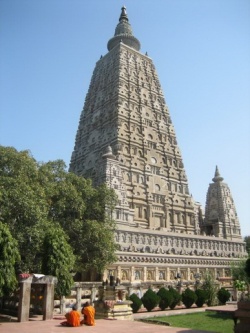Difference between revisions of "Mahābodhi Temple"
m (Text replacement - "The Buddha" to "The Buddha") |
m (Text replacement - "Times" to "Times") |
||
| Line 1: | Line 1: | ||
[[File:Mahābodhi_Temple.jpg|thumb|250px|]] | [[File:Mahābodhi_Temple.jpg|thumb|250px|]] | ||
| − | The Mahā[[Bodhi]] [[Temple]] is the large building erected over the place where The [[Buddha]] attained [[Enlightenment]] at [[Bodh Gayā]]. Legend says that [[King]] [[Aśoka]] built the first [[temple]] at [[Bodh Gaya]], a legend probably based on fact. Who built the present [[temple]] and when is not known, but the first record of it dates from the early 5th century CE. The [[temple]] is built in the classical fivefold plan (pañcāyatana) and consists of a rectangular base with an arched chamber (garbha) in it, a large inward-sloping spire (sikhara) rising from its centre and smaller spires at each of its four corners. The central spire is 52 meters high and is crowned with an āmalaka, a flattened, round and ribbed [[Form]] common to [[Indian]] [[temples]]. Other than the pillars on the portico, the floor and the door frames which are of stone, the whole [[temple]] is built out of brick. The [[Altar]] (āsana) inside the [[temple]] chamber, now with a large [[Buddha]] image on it, marks the ‘[[Diamond]] Throne’ ([[Vajrāsana]]), the ‘Navel of the [[Earth]]’ (Paṭhavīnābhi), the very place where The [[Buddha]] was sitting when he attained [[Enlightenment]]. The [[Bodhi Tree]] that now grows at the back of the [[temple]] is distantly related to the original one. The Mahā[[Bodhi]] [[Temple]] was remodeled and renovated many | + | The Mahā[[Bodhi]] [[Temple]] is the large building erected over the place where The [[Buddha]] attained [[Enlightenment]] at [[Bodh Gayā]]. Legend says that [[King]] [[Aśoka]] built the first [[temple]] at [[Bodh Gaya]], a legend probably based on fact. Who built the present [[temple]] and when is not known, but the first record of it dates from the early 5th century CE. The [[temple]] is built in the classical fivefold plan (pañcāyatana) and consists of a rectangular base with an arched chamber (garbha) in it, a large inward-sloping spire (sikhara) rising from its centre and smaller spires at each of its four corners. The central spire is 52 meters high and is crowned with an āmalaka, a flattened, round and ribbed [[Form]] common to [[Indian]] [[temples]]. Other than the pillars on the portico, the floor and the door frames which are of stone, the whole [[temple]] is built out of brick. The [[Altar]] (āsana) inside the [[temple]] chamber, now with a large [[Buddha]] image on it, marks the ‘[[Diamond]] Throne’ ([[Vajrāsana]]), the ‘Navel of the [[Earth]]’ (Paṭhavīnābhi), the very place where The [[Buddha]] was sitting when he attained [[Enlightenment]]. The [[Bodhi Tree]] that now grows at the back of the [[temple]] is distantly related to the original one. The Mahā[[Bodhi]] [[Temple]] was remodeled and renovated many Times over the centuries. By the middle of the 19th century it was badly decayed and was completely repaired in 1880 by the British [[Indian]] government. |
Navel of the [[Earth]]-The History and Significance of [[Bodh Gaya]], S. Dhammika, 1996. | Navel of the [[Earth]]-The History and Significance of [[Bodh Gaya]], S. Dhammika, 1996. | ||
Revision as of 04:45, 14 September 2013
The MahāBodhi Temple is the large building erected over the place where The Buddha attained Enlightenment at Bodh Gayā. Legend says that King Aśoka built the first temple at Bodh Gaya, a legend probably based on fact. Who built the present temple and when is not known, but the first record of it dates from the early 5th century CE. The temple is built in the classical fivefold plan (pañcāyatana) and consists of a rectangular base with an arched chamber (garbha) in it, a large inward-sloping spire (sikhara) rising from its centre and smaller spires at each of its four corners. The central spire is 52 meters high and is crowned with an āmalaka, a flattened, round and ribbed Form common to Indian temples. Other than the pillars on the portico, the floor and the door frames which are of stone, the whole temple is built out of brick. The Altar (āsana) inside the temple chamber, now with a large Buddha image on it, marks the ‘Diamond Throne’ (Vajrāsana), the ‘Navel of the Earth’ (Paṭhavīnābhi), the very place where The Buddha was sitting when he attained Enlightenment. The Bodhi Tree that now grows at the back of the temple is distantly related to the original one. The MahāBodhi Temple was remodeled and renovated many Times over the centuries. By the middle of the 19th century it was badly decayed and was completely repaired in 1880 by the British Indian government.
Navel of the Earth-The History and Significance of Bodh Gaya, S. Dhammika, 1996.
